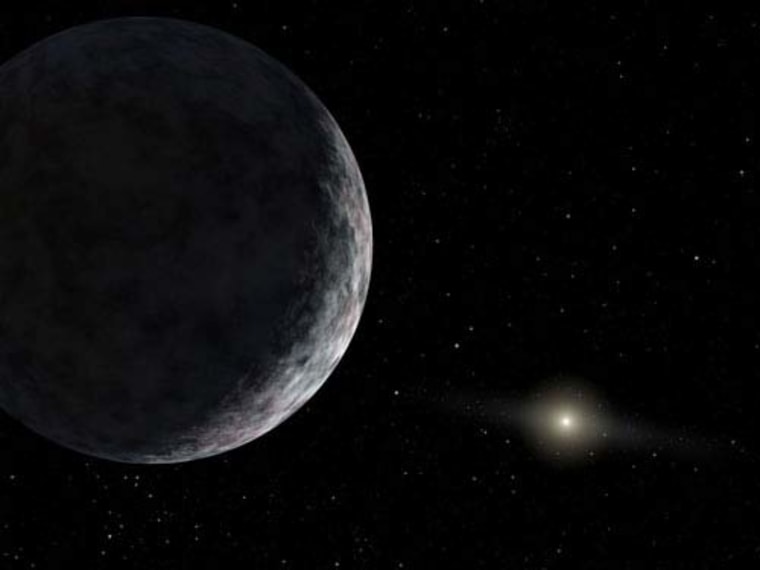Strange weather on the icy dwarf planet Eris could be causing changes that scientists are now seeing at the methane-ice surface of this distant object in our solar system.
Eris is the largest known solar-system object beyond the orbit of Neptune. It is larger than Pluto, with a diameter of ranging somewhere between about 1,490 miles and 1,860 miles.
A team of researchers examined data on Eris collected from the MMT Observatory in Arizona. They specifically looked at concentrations of methane ice based on light-reflection and absorption information.
Their results show possibly nitrogen ice mixed in with the methane ice covering Eris' surface. And the relative amount of nitrogen ice increases with depth into the ice, they found.
Here's what the researchers think is happening:
Currently, Eris is at its farthest distance to the sun, called aphelion, along its about 560-year orbit, meaning the planet is nearly 100 astronomical units (AU) from the sun, or about 9 billion miles. Along its orbit, Eris sweeps as close as 38 AU to the sun when at perihelion.
Due to Eris' tilt, a different hemisphere faces the sun when at perihelion and aphelion.
On the sunlit hemisphere or pole at perihelion, lots of sublimation would have occurred to turn nitrogen into gas. (Sublimation is the process of ice turning to gas while skipping the liquid phase.) This gas would build up in the atmosphere — likely a very thin one around such a small object — to increase the pressure and drive winds toward the shaded pole.
Slideshow 12 photos
Month in Space: January 2014
Nitrogen ice turns into a gas at cooler temperatures and so there would be more nitrogen gas in the atmosphere compared with methane. Then, at the shaded pole, also called the winter hemisphere, the gases would condense into snow-like or dew-like material that would fall onto Eris' surface as nitrogen ice.
As Eris moved closer and closer to the sun, this same process would occur for methane, with methane sublimating on the sunlit hemisphere and falling as methane ice on the shaded pole.
As the winds continued to blow from the sunlit side to the shaded hemisphere (as summer progressed on the sunlit side), nitrogen would be depleted. And so relatively more methane would whoosh over to the shaded side and fall as methane ice.
The pole the researchers observed had been shaded for years while Eris was at perihelion. That same pole is now facing the sun and has been for decades to centuries, the researchers say.
"The hemisphere in darkness then, is the hemisphere we are seeing now at aphelion today," researcher Stephen Tegler, an astrophysicist at Northern Arizona University, told SPACE.com. "In other words, we may be observing today a signature of the winds that condensed out during the last perihelion passage."
This apparent weather could explain why the researchers found more nitrogen deeper below the surface of Eris, which would've been deposited earlier in the season.
The research will be detailed in an upcoming issue of the journal Icarus.

